This time our theme is the automotive 48V system, including 48V automotive electrical system and 48V mild hybrid system.
When Mercedes-Benz invented the first internal combustion engine car, there was no battery and no electrical equipment, and the car was very rudimentary.
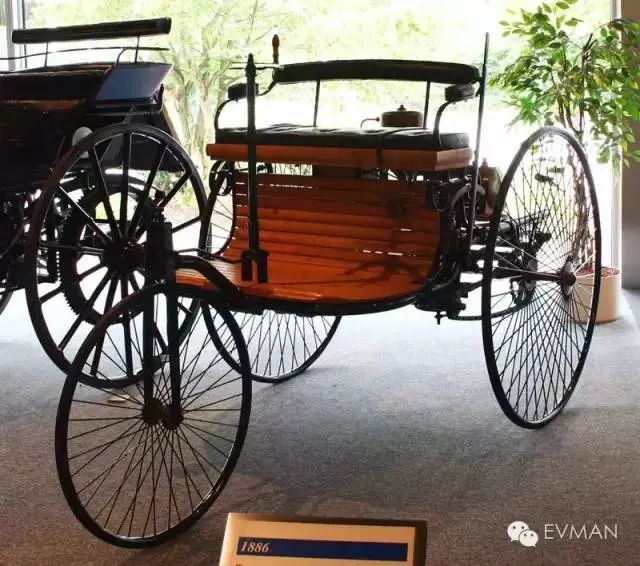
The first mass production car is like this - Benz Patent-Motorwagen
In 1918, the car was first introduced into the battery. With the birth of the starter, the battery was widely used in 1920. At that time, the voltage level of the battery was 6V, and the positive pole was grounded. Due to the increase in displacement of internal combustion engines and the emergence of high compression ratio internal combustion engines, 6V batteries have been unable to meet power requirements. The 1950s voltage level began to evolve to 12V, and until now, the 12V voltage system has been ruled for more than 60 years.
In 1988, SAE (Society of Automotive Engineers) proposed to increase the standard voltage to 42V. Due to the technical level at the time and the high cost of replacing electrical components, the automobile companies did not actively promote the implementation. Even with the increase of electrical equipment, the battery could not meet the power demand of the body equipment, and the automobile enterprises took a big cut. A method of power loading to reduce the load on the battery. 42V has not been promoted, so far the car is still a 12V system.
1
Proposal of 48V system
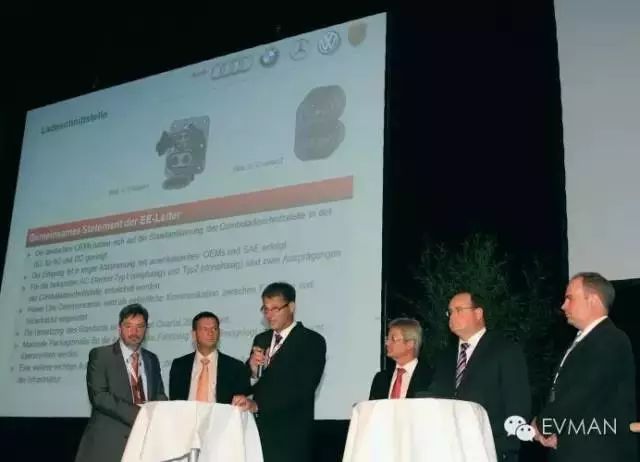
After introducing the start-stop mechanism, the 12V voltage system has basically reached the power output limit. If the light-mixing system is introduced at 12V, the power demand is about 10kW~15kW. Under such voltage, the output current of the battery is as high as 1000A, which obviously does not work. .
In 2011, Audi, BMW, Porsche, Volkswagen, and Daimler jointly launched a 48V system to meet the growing demand for on-board loads and, more importantly, to meet stringent emissions regulations in 2020. And subsequently released the 48V system specification LV148.
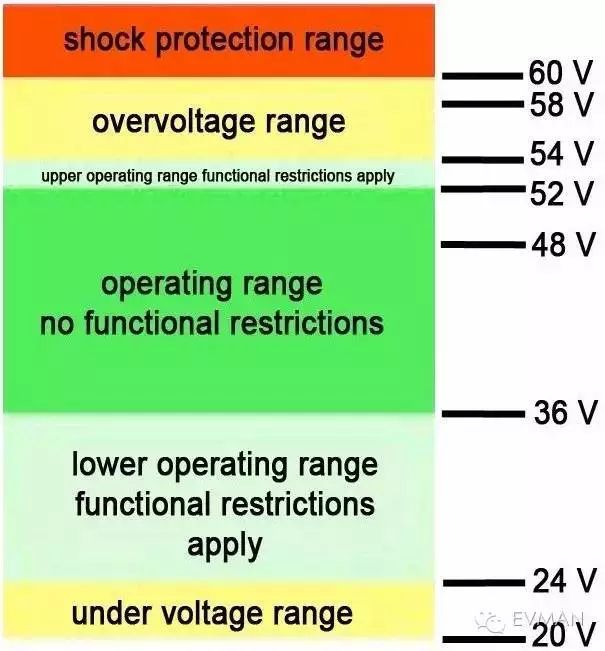
Voltage range specified by LV 148
As for why choose 48V:
1. Technological progress usually grows exponentially;
2. 60V is a safe voltage, which means that as long as the voltage below 60V does not require additional safety measures, the charging voltage of the 48V battery is up to 56V, which is very close to 60V, that is, the 48V battery voltage is the highest voltage level under the safe voltage. It is.

National emission targets
In the emission regulations, the EU has the most stringent requirements. By 2020, the fuel consumption per 100 kilometers will be reduced to 4L, and the carbon dioxide emissions per kilometer will be as low as 95g. Obviously, simply relying on improving the fuel efficiency of the engine to achieve the emission target is basically impossible. The hybridization of the car and pure electricization are the best technical routes.
Although pure electricization is the ultimate goal of the car, it cannot be widely popularized in the short term due to high cost and battery life.
Compared with the high-pressure hybrid system, the 48V light-mixing system has lower cost, but can achieve most of the energy-saving effect of the high-pressure hybrid system (battery voltage>100V). According to Delphi's calculation, the 48V light-mixing system is the cost of high-pressure light-mixing system. 30% can achieve 70% energy saving effect of high pressure light mixing system.
2
Advantages of 48V Light Mixing System
1. Below 60V safe voltage, no additional voltage protection is required, and the cost is lower than the high pressure hybrid system;
2. Compared with the 12V system, the operating current is only 1/4 at the same power, and the loss is only 1/16 of the 12V system;
3. Due to the electric power assistance of BSG/ISG, the volume of the engine can be further reduced, thereby reducing emissions;
4. It can motorize high-load accessories on traditional engines, such as air-conditioning compressors, cooling water pumps, vacuum pumps, etc., to reduce the load on the engine, even if the engine is off, these devices can work;
5. Raise the working voltage of the vehicle electrical appliance to 48V, which can further reduce the loss and reduce the outer diameter of the wire harness;
6. Can support more powerful on-board equipment.
7. The turbine can be motorized to further improve the efficiency of the engine without turbocharger delay;
8. BSG/ISG has a shorter ignition time, lower noise and less vibration.
9. The 48V Belt Starter Generator (BSG) is an easy replacement for the original 12V Belt Starter Generator and can be retrofitted without major changes to the design.
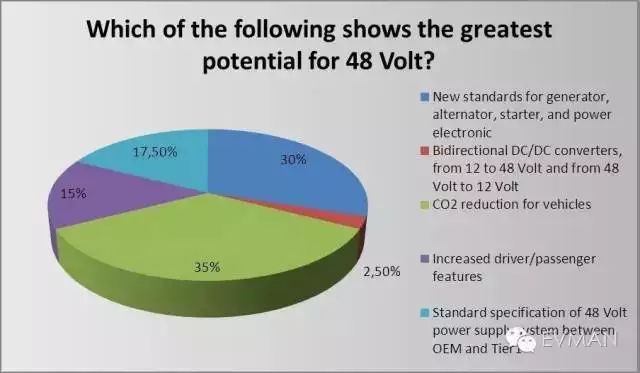
3
Disadvantages of 48V light mixing system
1. The voltage increase will make the electromagnetic compatibility requirement higher;
2. There will be arc under 48V voltage, which is a risk hazard and needs to be handled;
3. The migration of the original 12V vehicle equipment to 48V requires redevelopment and testing, which is costly and has a long cycle;
4. Higher cost than 12V start-stop system, energy saving effect is not as good as high pressure hybrid system.
4
48V system technical solution
The 48V light-mixing system does not directly raise the system standard voltage directly to 48V, but retains the original 12V electrical system and adds a 48V light-mixing system.
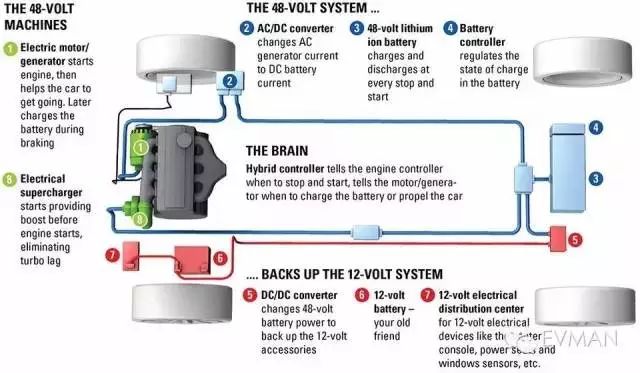
48V light mix basic framework (from delphi)
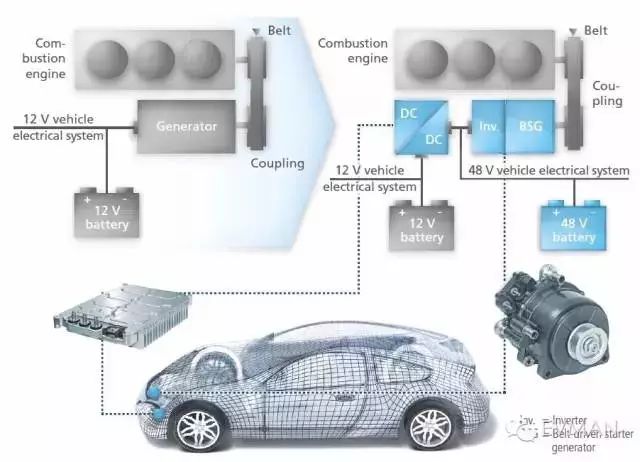
48V system: upgrade of 12V system
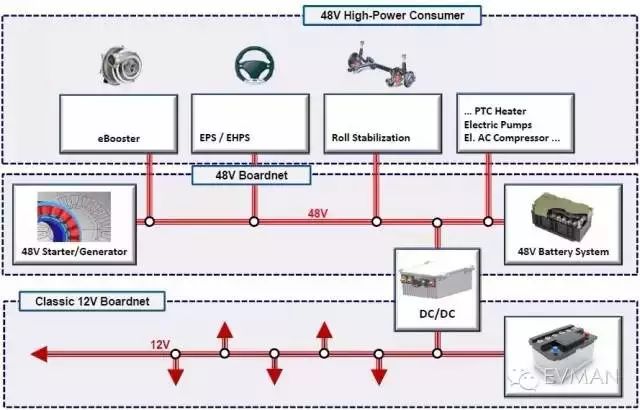
48V light mixing system electrical structure
The 48V light mixing system can be seen as an upgraded version of the 12V start-stop system, adding 48V energy storage battery, 48V/12V bidirectional DCDC, 48V BSG (belt-driven starter generator)/ISG (intergrated starter generator), electric supercharger (optional configuration), battery management system.
According to the location of the BSG can be divided into:

48V BSG+P0
The BSG is in the P0 position (located on the front side of the engine). This arrangement minimizes the modification of the vehicle, replacing the traditional starter with a BSG and eliminating the traditional generator. However, the BSG cannot be separated from the engine. During the energy recovery phase, even if the fuel injection system is turned off, the engine is still running, and the drag resistance of the engine directly reduces the recoverable energy. Under NEDC conditions, it can reduce carbon dioxide emissions by 13%.
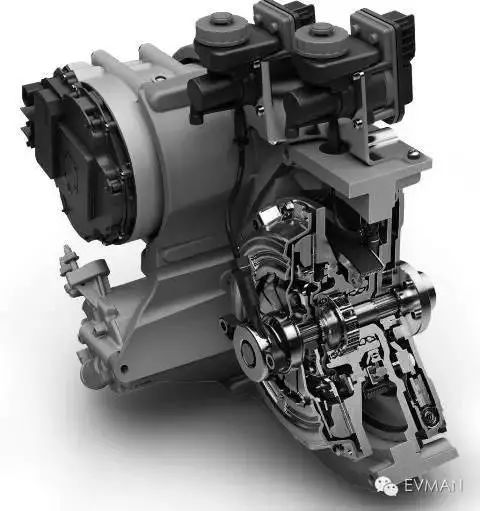
48V BSG+P2
The BSG/ISG is in the P2 position (between the engine and the gearbox), and the energy recovery phase completely shuts down the engine, further reducing CO2 emissions by around 25%. And pure electric drive can be realized, but the double clutch is required to separate the motor from the engine and the gearbox. The BSG can be further upgraded to ISG at the P2 position, removing the belt drive and achieving a higher level of integration.
5
48V light mixing system working mode
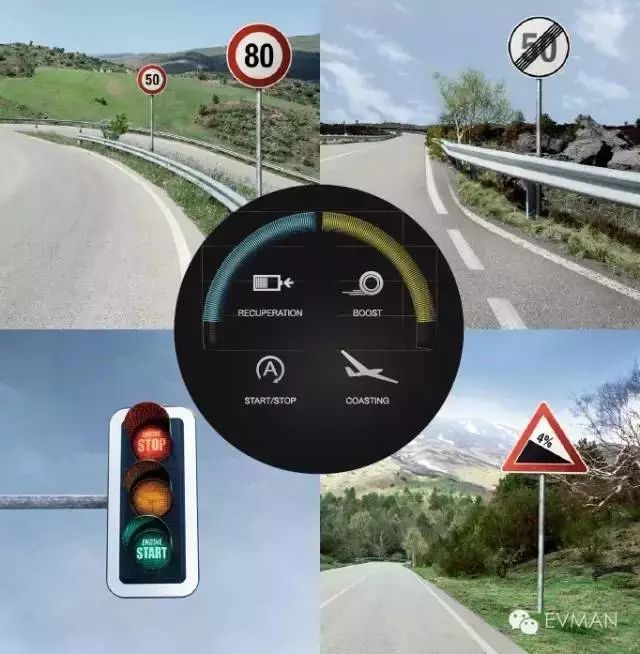
Automatic start/stop (START/STOP): Wait for the traffic light. When the vehicle is at rest, the engine is off. The 48V large-capacity battery uses the stored energy to maintain the normal operation of the vehicle electrical system. The engine can be started quickly at any time.
RECUPERATION: Energy recovery converts kinetic energy into electrical energy and stores it in the battery. Only the energy recovery function can reduce fuel consumption by about 7%.
Power assist (BOOST): The hybrid system can reduce the displacement of the engine. In the speed-up phase, the auxiliary power of the motor can make up for the lack of engine power and reduce emissions without losing power.
SAILING/ACTIVE ENGINE-OFF COASTING: When the vehicle is running at a constant speed and the battery is fully charged, the engine fuel injection system is turned off and the motor is used to maintain the vehicle operation. The power provided by the motor is used to offset the running resistance and the drag resistance of the engine. The BSG/ISG at the P2 position can completely separate and shut down the engine during high-speed cruise, with sufficient power to keep the vehicle cruising. When the accelerator pedal is pressed again, the engine will start quickly and smoothly cut into the current speed.
COASTING: When the throttle is released and the vehicle is in the coasting phase, the clutch separates the mechanical connection between the engine and the transmission system, completely shutting down the engine and achieving a longer driving distance. It is equivalent to the traditional vehicle neutral taxiing, except that after the traditional vehicle is switched to neutral, the engine speed needs to be injected to maintain the engine when it is reduced to idle speed.

P0 frame (BSG is located on the front side of the engine) working mode
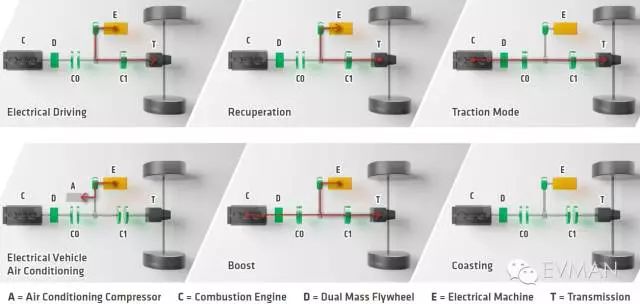
P2 frame (BSG is located between the engine and the gearbox) operating mode
6
48V system core component supplier
Bosch
Bosch offers a complete solution for the 48V system: the BRS system (Boost Recuperation System) and plans to mass production in 2017. I believe that most of the domestic OEMs will smash it.
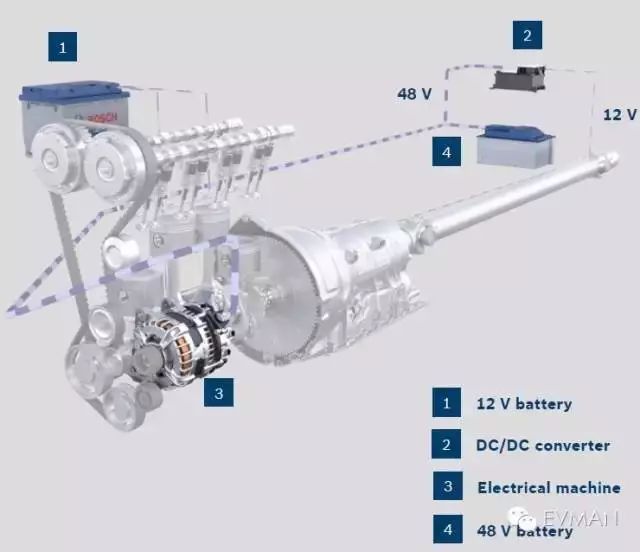
Bosch BSG solution
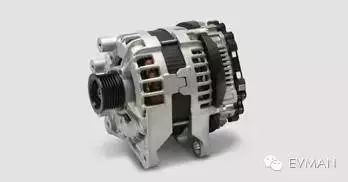
â–¶ Air-cooled claw pole motor with integrated drive and fan
â–¶ Maximum efficiency 88%
â–¶ Starting torque: up to 56Nm (converted to approximately 160Nm on the crankshaft)
â–¶ Energy recovery output power: up to 11.5 kW @ 48 V
â–¶ Electric mode mechanical power output: up to 9.7kW @ 48V
â–¶ Weight: ~ 8.5 kg
▶ Size [Ø x L]: 148 x 169 mm

â–¶ 48V/12V bidirectional multiphase buck-boost DC/DC Converter
▶ Maximum efficiency (≥ 96%)
â–¶ Rated voltage: 48/12 V
â–¶ Continuous output power at rated voltage: 3kW
â–¶ Weight: 2.7 kg
â–¶ Size: 220 x 183 x 75 mm
On May 21, 2016, FIA Electric, New Energy Commission, German Motorsport Association (DMSB) jointly released a karting machine using Bosch BRS system in Berlin, equipped with 2 BSGs, with a total power of 20kW and less than 5 seconds of acceleration in 100 kilometers. It can be considered that this is Bosch's application test for the BRS system that will be mass-produced next year.
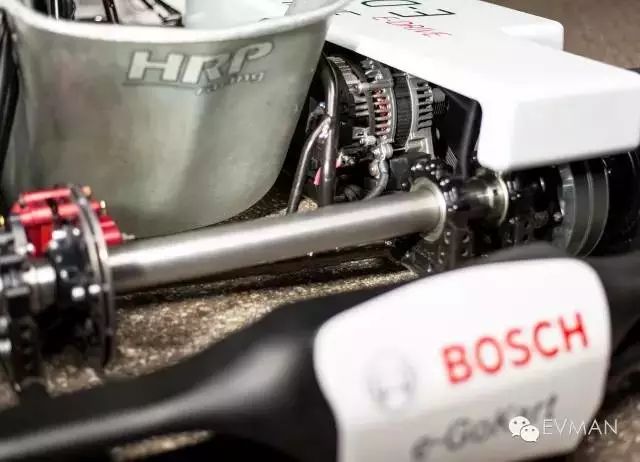
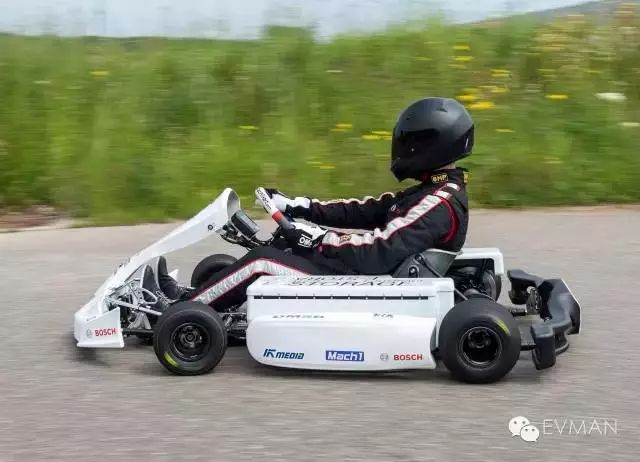
Continental & Shaeffler:
Although Schaeffler's acquisition of the mainland failed, it still holds 46% of the mainland's shares, so the cooperation between the mainland and Schaeffler in the 48V light-mix system is also logical.
The 48V system of the mainland and Schaeffler is called GTC (Gasoline Technology Car) and has been developed to the second generation.

GTC I uses the P0 architecture to reduce carbon dioxide emissions by 13%
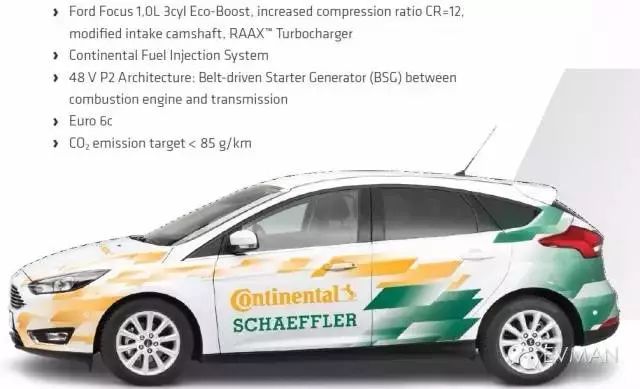
GTC II has established a close relationship with Ford
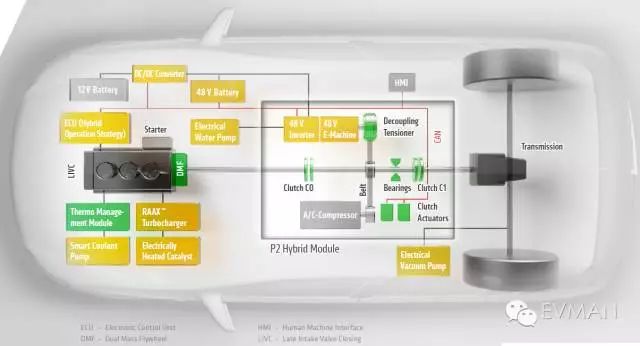
GTC II based on the P2 architecture of the vehicle layout
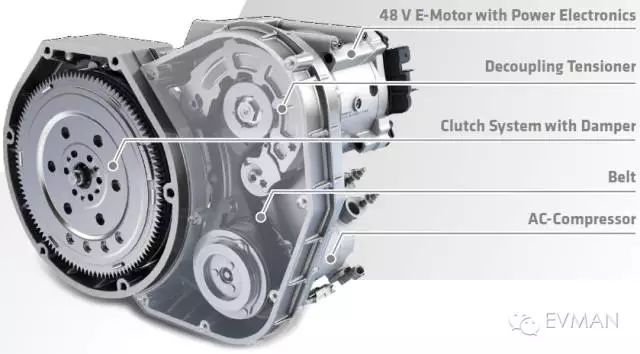
GTC II BSG based on P2 architecture
The second-generation GTC II uses the P2 architecture, which integrates the BSG between the engine and the transmission. The two clutches separate the engine from the driveline or independently. The engine can be shut down and separated during the sailing/sliding phase for longer glide distances and more energy recovery. GTC II can reduce fuel consumption by 25%.
Continental & Schaeffler GTC System
According to the plan of Continental & Schaeffler, GTCI will be put into production in 2016, GTCII will be put into production in 2020, BSG in GTCII will be upgraded to ISG in 2025, the belt will be cancelled, and the motor will be upgraded to permanent magnet motor (currently using induction motor BSG).
Delphi Delphi
Delphi is currently launching a 48V BSG system based on the P0 architecture and has been validated on the Honda Civic 1.6L diesel to reduce CO2 emissions by more than 10%.

Delphi 48V system test sample car
In April 2016, Delphi announced that it has reached a cooperation with two customers and plans to mass-produce 48V systems in 2017.
Delphi 48V System
Valeo
Valeo offers core components for the 48V light mixing system, including 48V electric supercharger, BSG, clutch, DCDC.

Valeo's 48V system core components
AVL:
AVL offers a 48V system solution that integrates the entire system and provides calibration, control strategies, and prototype trial services.

AVL test sample car
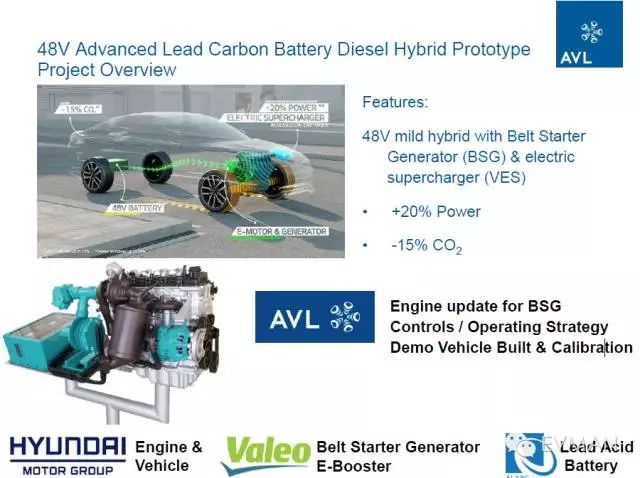
AVL System Integration Service
7
48V system battery
Similar to pure electric power, the 48V light-mixing system basically uses lithium batteries as the energy storage power battery. Johnson Controls, Hitachi, SAFT, A123, etc. all have dedicated batteries for 48V light mixing.

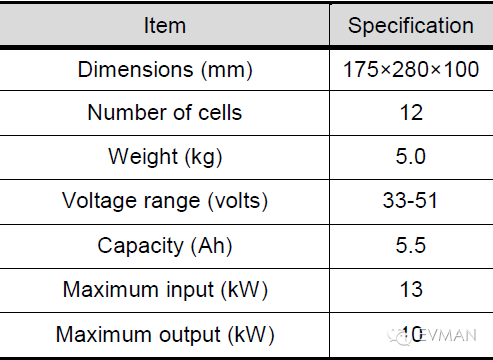
April 20, 2016, Hitachi released 48V system lithium-ion battery

Johnson Controls 48V Lithium Ion Battery
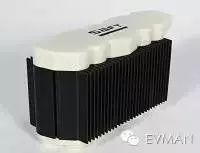
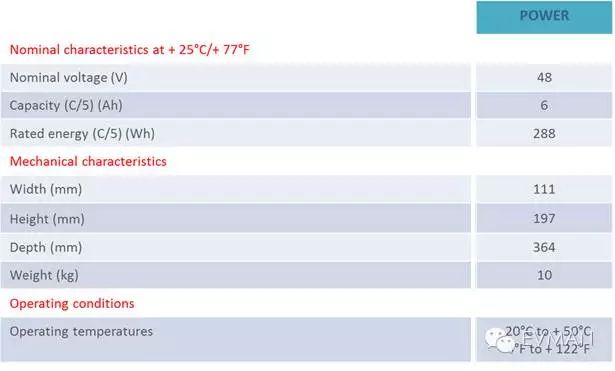
SAFT's 48V lithium battery with a maximum output of 13kW
In addition to lithium-ion batteries, the European Advanced Lead-Acid Battery Consortium (EALABC) is also actively promoting the application of high-power density lead-acid batteries in 48V systems. Lead-acid batteries are less expensive and waste batteries can be 100% recycled. It also works at -30 degrees, does not require active heat dissipation, and does not require an expensive battery management system. Lithium batteries have high power density, but have very poor low temperature characteristics, require additional thermal management systems to maintain proper operating temperatures, and require complex battery management systems.
EALABC is working with AVL Schrick, Controlled Power Technologies, East Penn, Exide, Faurecia, Furukawa, Innovate UK (previously known as the UK Technology Strategy Board), Mubea, Provector, Ricardo, University of Nottingham, US Department of Energy, Valeo Application of high power density lead-acid batteries in 48V systems.
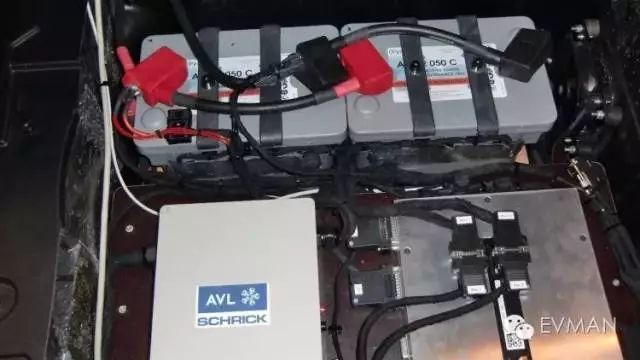
48V system test prototype equipped with lead-acid battery
8
48V light mixing system future
In addition to the active promotion of European car companies, Ford, Hyundai and Kia also indicated that they will develop 48V models. GM said it will introduce 48V systems when appropriate.
Domestically, Geely, FAW, BYD and Great Wall confirmed the introduction of 48V system.
Europe is the main battlefield for the future 48V system. European car companies and component suppliers are more optimistic and promoted very positively. If Europe promotes smoothly, I believe China will follow closely.
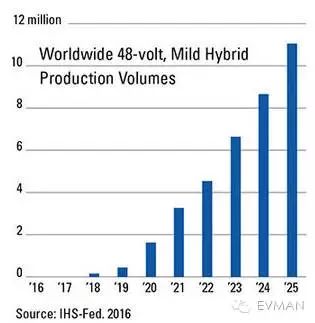
According to IHS forecast, the installed capacity of 48V system in 2025 is 11 million.
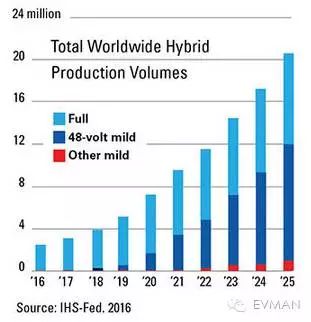
IHS predicts that 48V light mixing and high pressure mixing will equalize the world in 2025
Of course this is a very optimistic forecast. On the one hand, there are emission regulations, and on the other hand, there are low-cost advantages.
Passive Stylus Pen,Custom Stylus Pen,Stylus Pen For Surface,Smart Stylus Pen
Shenzhen Ruidian Technology CO., Ltd , https://www.wisonens.com